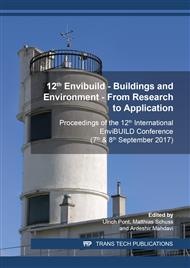p.527
p.539
p.547
p.553
p.561
p.571
p.579
p.587
p.597
Exploring the Potential of Simulation Model Calibration an Acoustical Retrofit Case Study
Abstract:
The success of gastronomic facilities is due, not in a small part, to perceived indoor atmosphere. This includes not just the interior design but also lighting and acoustics. Especially acoustics is a crucial parameter concerning the perception of the environment, but it is often neglected. The present case study investigates the usability and accuracy of acoustics simulation as applied to the retrofit project of a restaurant. The restaurant space was modelled in CAD-based modelling environment. Subsequently, acoustical simulations based on ray tracing were conducted and the simulation model was calibrated based on on-site measurements of the reverberation time. The initial simulation showed large deviations from the measured values, mainly because of uncertainties in the input data concerning the absorption properties of the used materials. Within three calibration steps, the model was revised, such that better results could be achieved. Subsequently both the initial and the calibrated models were used to develop strategies for the improvement of the acoustical performance of the space. After the implementation of the new design options in the restaurant, measurements were repeated. Again the results were compared with both the initial and the calibrated model. The results suggest that the calibrated model displayed a better performance regarding the prediction of post-retrofit circumstances when compared to the non-calibrated one.
Info:
Periodical:
Pages:
561-568
Citation:
Online since:
January 2019
Authors:
Keywords:
Price:
Сopyright:
© 2019 Trans Tech Publications Ltd. All Rights Reserved
Share:
Citation:


